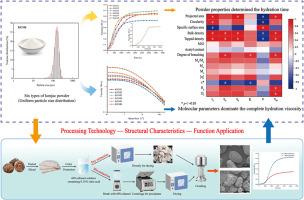Investigating critical determinants governing hydration characteristics of konjac glucomannan
IF 11
1区 农林科学
Q1 CHEMISTRY, APPLIED
引用次数: 0
Abstract
As a viscous soluble dietary fiber, the hydration behavior of konjac glucomannan (KGM) is crucial for its food and pharmaceutical utilization. Although the increase in viscosity during hydration is an inherent property of KGM, six commercially available KGM samples exhibited different hydration behaviors even after the elimination of particle size effects, with hydration times ranged from 16.82 to 100.90 min, and solution viscosities at 30 s−1 shear rate varied from 0.59 to 1.05 Pa s. Detailed analysis of physicochemical properties of KGM revealed essential factors for these differences. The results indicated that the hydration rate was mainly regulated by the powder properties. Hydration time correlated significantly with particle density and specific surface area (p < 0.05). KGM samples with the highest tapped density (0.9416 g/cm3) and smallest specific surface area (384.29 cm2/cm3) exhibited the longest hydration time (100.90 min). Moreover, the viscosity after complete hydration was driven by its molecular characteristics. KGM samples with a larger radius of gyration (57.51 nm) and higher branching (1.47 %) ultimately exhibited higher viscosity (1.05 Pa s). Further analysis also revealed that the effect of processing methods on the hydration properties of KGM. Wet-extracted KGM showed higher tapped density (1.0406 g/cm3) and lower specific surface area (387.46 cm2/cm3), which ultimately led to longer hydration time (108.33 min) compared to dry extraction. These findings revealed the mechanisms by which physical properties govern the hydration efficiency and molecular structure determined the final viscosity, providing insights for optimizing its functionality in food and pharmaceutical products.

研究魔芋葡甘露聚糖水化特性的关键决定因素
魔芋葡甘露聚糖作为一种粘性可溶性膳食纤维,其水化性能对其食品和医药利用至关重要。虽然在水化过程中粘度的增加是KGM的固有特性,但即使在消除粒径影响后,6种市买KGM样品也表现出不同的水化行为,水化时间从16.82到100.90 min不等,30 s−1剪切速率下的溶液粘度从0.59到1.05 Pa s不等。对KGM的理化性质进行详细分析,揭示了这些差异的基本因素。结果表明,水化速率主要受粉体性质的影响。水化时间与颗粒密度和比表面积显著相关(p < 0.05)。丝锥密度最高(0.9416 g/cm3)、比表面积最小(384.29 cm2/cm3)的KGM样品水化时间最长(100.90 min)。完全水化后的黏度受其分子特性的驱动。具有较大旋转半径(57.51 nm)和较高分支(1.47%)的KGM样品最终表现出较高的粘度(1.05 Pa s)。进一步分析还揭示了加工方法对KGM水化性能的影响。湿法提取的KGM具有较高的提取密度(1.0406 g/cm3)和较低的比表面积(387.46 cm2/cm3),最终导致了较长的水化时间(108.33 min)。这些发现揭示了物理性质决定水合效率和分子结构决定最终粘度的机制,为优化其在食品和药品中的功能提供了见解。
本文章由计算机程序翻译,如有差异,请以英文原文为准。
求助全文
约1分钟内获得全文
求助全文
来源期刊

Food Hydrocolloids
工程技术-食品科技
CiteScore
19.90
自引率
14.00%
发文量
871
审稿时长
37 days
期刊介绍:
Food Hydrocolloids publishes original and innovative research focused on the characterization, functional properties, and applications of hydrocolloid materials used in food products. These hydrocolloids, defined as polysaccharides and proteins of commercial importance, are added to control aspects such as texture, stability, rheology, and sensory properties. The research's primary emphasis should be on the hydrocolloids themselves, with thorough descriptions of their source, nature, and physicochemical characteristics. Manuscripts are expected to clearly outline specific aims and objectives, include a fundamental discussion of research findings at the molecular level, and address the significance of the results. Studies on hydrocolloids in complex formulations should concentrate on their overall properties and mechanisms of action, while simple formulation development studies may not be considered for publication.
The main areas of interest are:
-Chemical and physicochemical characterisation
Thermal properties including glass transitions and conformational changes-
Rheological properties including viscosity, viscoelastic properties and gelation behaviour-
The influence on organoleptic properties-
Interfacial properties including stabilisation of dispersions, emulsions and foams-
Film forming properties with application to edible films and active packaging-
Encapsulation and controlled release of active compounds-
The influence on health including their role as dietary fibre-
Manipulation of hydrocolloid structure and functionality through chemical, biochemical and physical processes-
New hydrocolloids and hydrocolloid sources of commercial potential.
The Journal also publishes Review articles that provide an overview of the latest developments in topics of specific interest to researchers in this field of activity.
 求助内容:
求助内容: 应助结果提醒方式:
应助结果提醒方式:


